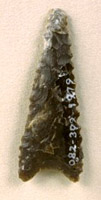|
Most archaeological accounts of Late Great Basin Prehistory emphasize
evidence of a major migration, circa CE 1000, of Shoshonean-speaking
peoples (of the Uto-Aztecan linguistic family) spreading through the
Great Basin and moving south and west through southern California.
This movement, which ostensibly displaced prior resident groups and effected
dramatic and rapid culture changes, is referred to by anthropologists
as the “Shoshonean Wedge." One of
the archaeological indicators that support this theory is the proliferation
(after CE 1000, in many
localities) of distinctive arrow point types known as the "Cottonwood
Series" and the "Desert Series."

|
However, in the Antelope Valley and many other locations in southern
California, evidence does not fit this pattern. Rather, it supports the
idea of Shoshonean presence over a much longer period (at least the past
two thousand years), characterized by long-established
traditions (cultural continuity) and change over time of a more
gradual nature. (One suggested possible explanation is that groups of
the "Takic" family of
Shoshonean speakers began migrations from a common homeland much earlier
than did those of the "Numic" family.) These theoretical complexities
are the subject of continuous research, debate, and refinement by Great
Basin scholars.
In any case, for Late Prehistoric occupants of Antelope Valley, subsistence
patterns established in earlier periods--seasonal
hunting and gathering, combined with trading, remained intact. The Shoshoneans demonstrated
great adaptability and continuously improved
and refined their technological skills.
The Antelope Valley was occupied and/or used by at least four distinct
groups of Shoshonean speakers:
(1) Serrano (Takic), who lived near the foothills of the San Gabriel
Mountains and were related to valley floor dwellers (sometimes called "Vanyume");
(2) Kitanemuk (Takic), who
tended to concentrate in the western portion of the valley;
(3) Tataviam (Takic), located
in the vicinity of the Santa Clarita River; and
(4) Kawaiisu (Numic), who were
centered near to, and east of, present day Tehachapi.
The groups traded and interacted with each other. Additionally, each
group had its own trade and alliance relationships with other groups
who lived outside the valley. (For example, there seems to have been
much Chumash influence upon the Kitanemuk people.) To find related artifacts, SEARCH the collections
database.
(Text that appears in red indicates basic characteristics of the various
culture periods. Text in blue denotes important additional details.)
Antelope Valley
Native American Peoples
Initial Settlers << Previous |
Next >> The Spanish Arrive
|




